Araki's Motivation (August 2018)
Anime Expo (July 2018)
Interview Archive
An interview with Hirohiko Araki from Yahoo Japan, posted on August 17, 2018.
Interview
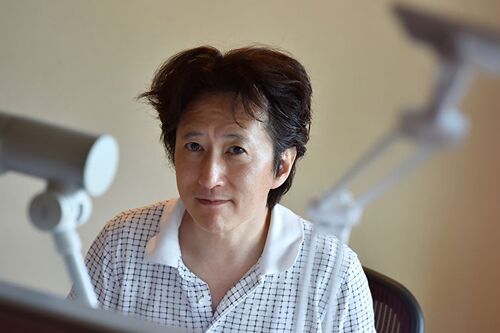
"You won't find a more Royal Road manga." - The reason why Hirohiko Araki continues to draw 'JoJo' 8/17 (Fri) 9:26 P.M. Distribution
From August 24th, the 'Hirohiko Araki JoJo Exhibition: Ripples of Adventure' will be held at the National Art Center, Tokyo. It is the first solo exhibition of a manga artist in 28 years since Osamu Tezuka at the National National Museum of Modern Art, Tokyo. "JoJo's Bizarre Adventure", which has continued for more than 30 years, supports the golden age of Weekly Shōnen Jump. There are more than 120 volumes of the tankōbon with spin-off works also produced. There are many creators representing various fields and people in the manga world who profess they're fans. Despite being called a 'Heretic in Jump' due to its unique designs and storyline, Araki-san asserts that "You won't find a more Royal Road manga." The key phrases are 'walking on the path of belief' And 'the power to open up'. (Satoshi Ishido / Yahoo! News Feature Editor)
'Heretical' goes against the Royal Road
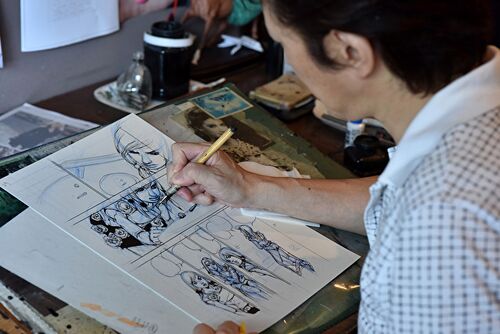
Araki-san inking at his usual work desk.(Photo: Seiji Tonomura)
Hirohiko Araki, 58, running a pen at a large desk by the window. On the desk there is a horse figurine and an origami frog that he used as a reference for drawing. It is for pick it up as an object.
The 'reality' of the details is the lifeblood of the work that is supporting the world. It is a desk where you can catch a glimpse of such a strong commitment.
"All I need is this desk. And then I can draw manga..."
He was drawing the latest episode of 'JoJolion', which is the eighth part of the series 'JoJo's Bizarre Adventure'. Before the exhibition, the mysterious story is nearing its end.
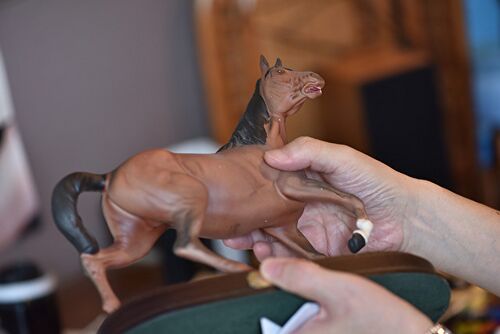
The figure that became the key horse motif in Part 7 of 'JoJo'. (Photo: Seiji Tonomura)
Araki-san has been drawing the story of 'JoJo' for more than 30 years, mainly for Shōnen manga magazines which are mercilessly discontinued if they are not popular. Many people now profess to be fans, but for a long time it was a "heretical" existence. Rather than a work that most of the class talked about, it was the kind of manga where a few people would gather in secret and confide in each other, saying "Actually, I like 'JoJo'" and "Me too." The reason for this is it's unique setting and storyline.
The serialization began in 1987. Four years earlier, 'Fist of the North Star', which began serialization, became a major breakthrough when it was adapted into an animated television series.'Dragon Ball' had started three years earlier and 'Saint Seiya' two years earlier. According to Araki, it was a time when blockbusters by "Geniuses in Shōnen manga" were made one after another.
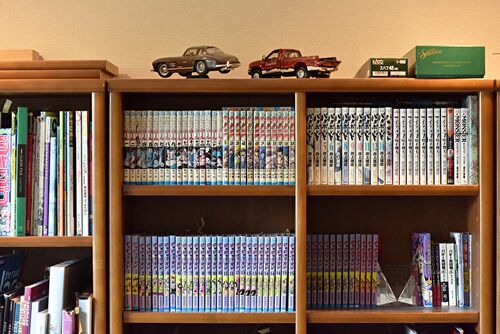
A number of manga that Araki found interesting are lined up on the top shelf of the bookshelf.(Photo: Seiji Tonomura)
The hero defeats the enemy. Then, even stronger enemies appear, and even stronger enemies appear after them, and manga that develops the story in a so-called 'Tournament Format' is the 'Royal Road' of Shōnen manga, and the number of copies and popularity were concentrated. The main character is often a Japanese boy or young man, to make it easier for readers to identify with them. The setting was regularly a town or school with a sense of familiarity.
'JoJo' went against the Royal Road in all respects.
The story, which has been going on for more than 30 years, begins like this. The setting is in England in the 19th century, 1880. Dio Brando, a boy from the slums who is adopted by Sir George Joestar, a prestigious aristocrat, after the death of his father, secretly plans to take over the Joestar family. Little by little, he hunts down George's only son, Jonathan Joestar - but...
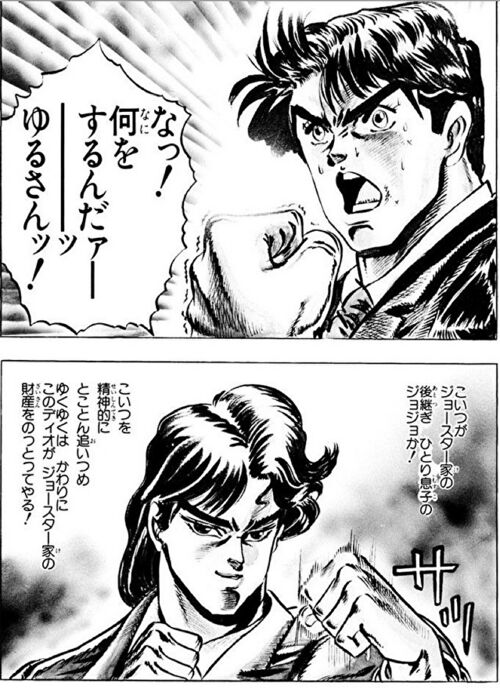
From "JoJo's Bizarre Adventure" Part 1, "Prologue". Jonathan (above) and Dio meeting scene © Hirohiko Araki / Shueisha
However, Araki-san asserts.
"You won't find a more Royal Road manga"
Why is that?
Overcoming the heyday of the 'Tournament Format'.
Ryosuke Kabashima, who was the first editor in charge of 'JoJo' and had seen Araki's work before his debut, looks back on those days.
"We were prepared to cancel it early on, and we were concerned about the setting."
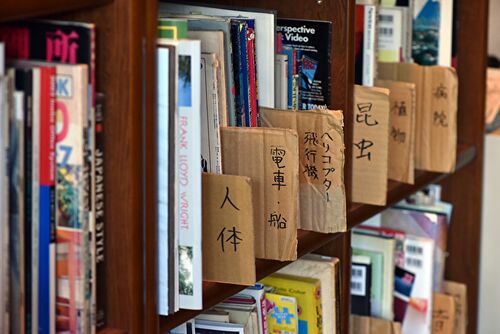
Bookshelves in the studio lined with materials of various genres.(Photo: Seiji Tonomura)
There was a reason for this. All of Araki-san's serials before 'JoJo' were short-lived. Kabashima-san analyzes the reasons for this.
"There weren't enough engaging characters. No matter strong the protagonist is, it will not be possible if there are no rivals or enemy characters who can stand alongside him or her. Then he says that his next work is set in 19th century England and has an nobleman as the main character. I became worried. There's no way a foreign protagonist could possibly succeed."
However, Araki-san did not fold.
"So, I started. The storyline was originally highly praised, so the editor-in-chief at the time gave the OK. What I thought was different was the villain. The villain, Dio, was really good."
Kabashima-san says that it is the villains that enhance the appeal of Shōnen manga characters.
"The nobleman Jonathan can't do anything wrong, he must be a gentleman at all times. A 'Good Boy Character' who is only righteous will not win sympathy. The story shines when Dio, the villain who wants to surpass human beings, is placed in contrast."
Even so, 'JoJo' was slow to gain popularity.
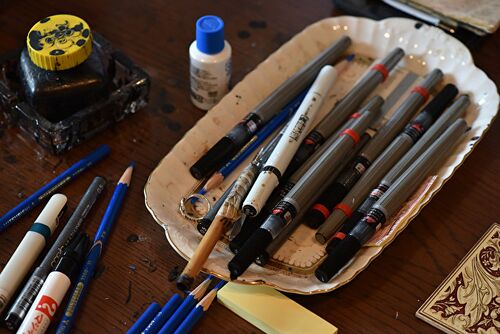
Tools that support the drawing of 'JoJo'. (Photo: Seiji Tonomura)
Here, Araki-san makes a move that surprises even Kabashima-san. It's a change of protagonist.
In the first part, Jonathan was the main character, and in the second part the story was livened up to a bright adventure drama with Joseph Joestar as the main character, a descendant who inherits Jonathan's will.
At the same time, this also had the effect of avoiding the Tournament Format. Since then, 'JoJo' has been portrayed through eight main characters leading up to "JoJolion".
Araki-san recalls.
"At that time, we were heading towards the bubble economy, so the atmosphere of the times was going up, up, up. Manga that adopted the Tournament Format coincided with the prevailing mood of the times. I couldn't get into that atmosphere. What should I do if I go up and eventually plateau? That's what I think."
That is why it was important for him to draw the manga he wanted to draw without being carried away by the times.
"I want to draw suspense, and that (Tournament Format) is not the manga I want to draw. If you wobble around what you want to draw, the manga is over."
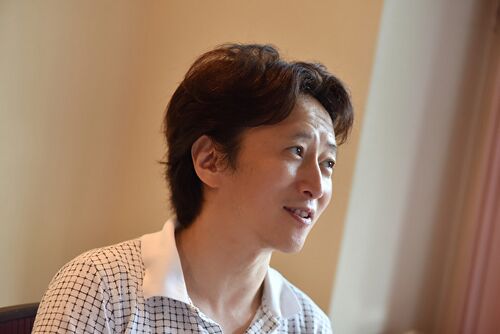
(Photo: Seiji Tonomura)
And break on 'Stand'
By continuing to draw what you believe in, the time for a break will eventually come.
Adopting a road movie approach, the third part marks a turning point as Japanese high school student, Jotaro Kujo, who inherits the Joestar family lineage, and his friends travel to Egypt to defeat the revived arch-enemy of the family, DIO.
For the first time, the idea of the "Ghostly Ripple (Stand)", the personification of psychic powers that symbolise the worldview of 'JoJo', was used. Kabashima-san thought, "Now, that's a hit.".
"The supernatural 'Ripple' ability used in Parts 1 and 2 was plain, and I thought it was not good enough to enhance the interest of Araki's story. So I told him to come up with a new idea for the part 3. That is how the Stand was born. It's an idea no one has seen before, and in part 3, both the heroes and villains are fit for it."
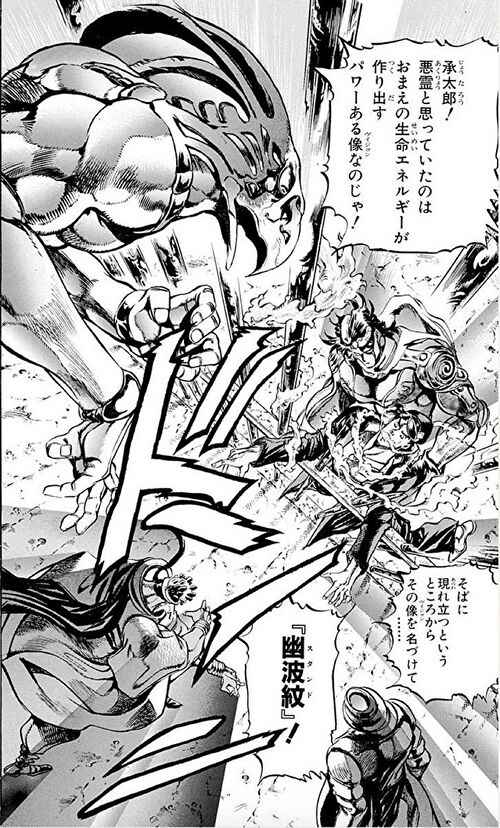
The scene where Stands are discussed in detail for the first time. From Part 3: Jotaro Kujo, Part 3 © Hirohiko Araki & LUCKY LAND COMMUNICATIONS/Shueisha.
Everyone's stand ability is different. Instead of following the Shōnen manga pattern where forces clash and the stronger one wins, he established a method of called 'brain battles' that uses the compatibility of abilities and intellect.
An enemy character who is too weak, on the other hand, becomes tough when even playing cards and video games were incorporated into the battles. Brain battles is a method that many Shōnen manga use nowadays, but you could say that 'JoJo' paved the way for it.
Araki-san says.
"I was told that Ripple was no good, so I wondered what to do. As an extension of the idea of expressing supernatural powers, I came up with the idea of personifying it. In Jump, it was also NG(Not Good) to be thought to have used other senseis' ideas, I wanted to do something I would never do. Perhaps because of that, it was hard to understand what a stand was at first. I was often asked, 'What's a stand?'"
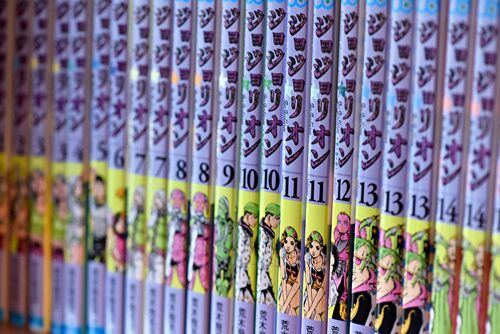
The 'JoJo' series has continued for over 30 years, up to Part 8, 'JoJolion'(Photo: Seiji Tonomura)
Until Jotaro and his friends head to Egypt, they visit India and other places and fight there. Even if there are no strong characters or stands one after another like in the Tournament Format, the story unfolds well.
Araki-san thought that it would be good if there was 'necessity' in the battle. Enemies that make use of their abilities are more "scary" than powerful enemies that simply appear. If there is fear, the story moves forward.
In Part 3, which also became very popular, DIO was defeated and the story concludes gracefully. In Part 4, the setting is also changed boldly, and it was set in the small town of Morioh in Japan. It incorporates a more suspenseful tone in which the protagonist, high school student Josuke Higashikata, searches for a serial killer lurking in town.
Araki-san has such a strong attachment to Josuke Higashikata that he chose him as his favorite character in his art book 'JOJO A-GO!GO!' published in 2000.
"I think that part 4 was the first time I was able to depict everyday life. Until then, I felt like I was drawing a myth. Jotaro is cool and, in a way, complete. But I feel like Josuke is around there (pointing to an empty chair). It's a character that's right next to you."
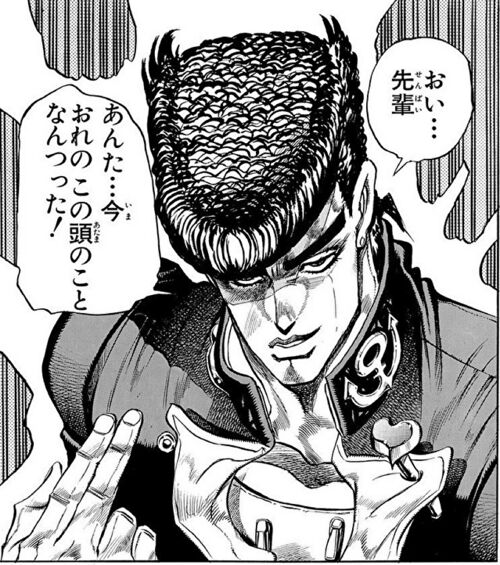
The protagonist of Part 4, Josuke Higashikata. He's usually mild-mannered, but when his hairstyle is criticized, he goes 'crazy'. From "JoJo's Bizarre Adventure" Part 4: Jotaro Kujo! Meet Josuke Higashikata Part 1 © LUCKY LAND COMMUNICATIONS/Shueisha
Having developed the ability to depict the horrors that lurk in everyday life, the JoJo model is completed, and the story progresses while greedily incorporating new elements until Part 8.
"You must always be positive"
The main character and setting change, so why does it continue as a single manga? That's because there is a consistent theme of 'human praise'. In his previous work, Araki-san says:
"It's a positive affirmation that 'humans are wonderful'. When faced with difficulties, it is through the power of human beings to solve them and pave the way. Convenient coincidences such as a god suddenly coming to the rescue or a magic sword suddenly falling out of the sky, being picked up to fight with and win never happen in JoJo" (from Hirohiko Araki's Manga Techniques).
Araki-san says that JoJo is a "Royal Road" because it has a theme that runs through the work and follows the rules of Shōnen manga.
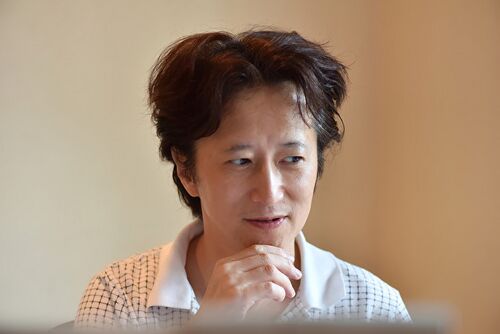
(Photo: Seiji Tonomura)
"I call 'JoJo' a royal road because the aspirations of the characters, be they protagonists or villains, are positive. I don't draw people who are troubled by it. It's normal to worry about life, so it's boring. I draw on the idea that when positive aspirations collide with each other, chemical changes and suspense are created. The character's vector must always be positive. Growing is the main principle. Don't worry about fighting. And when you fight, you must be alone."
Whether the characters in 'JoJo' are the protagonists or villains, they face the reality of 'lineage' and 'Destiny' that they cannot control on their own, and try to resist them and forge a path with their own power.
"The rule is that the characters in Shōnen manga must always be positive. If you put in the negative elements of being backwards and continuing to worry about fighting, readers will get fed up. 'JoJo' adheres to this rule faithfully. That's why I said it's Royal Road. Drive the protagonists into harsh situations and let them carve their way as they grow. You can't have 'JoJo' if you're relying on chance or someone else to do the fighting for you, you have to face it alone."
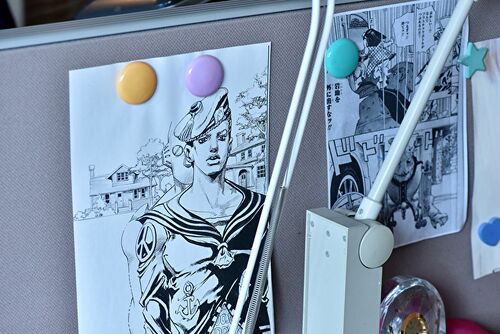
Part 8 "JoJolion" is underway((Photo: Seiji Tonomura)
Even the villains are positive
Araki-san applies this rule even to antagonists.
"Take, for example, the serial killer Kira Yoshikage, the boss of Part 4. What Kira does is unforgivable, but he has no regrets or hesitation. He acknowledges himself. For the sake of his own peaceful life,he is still willing to fight and make his own way even when the protagonists are hunting him down. That's why the Stand ability also grows.
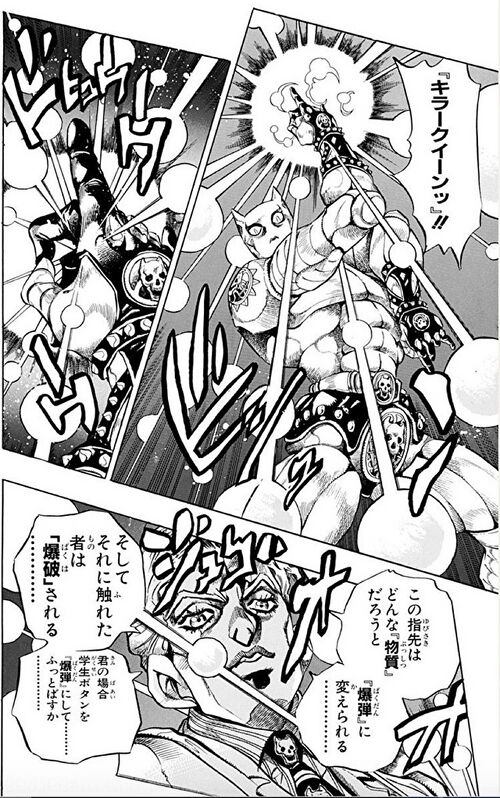
Yoshikage Kira, a murderer who makes full use of the stand "Killer Queen". From Part 4: Sheer Heart Attack Part 9 ©LUCKY LAND COMMUNICATIONS/Shueisha
Araki-san says that good and evil are actually "two sides of the same coin." The enemy has his own beliefs and reasons to fight. The president, the biggest villain of Part 7, also had a motive beyond his own self-interest to make America prosperous in his own way.
"The final judgment of right and wrong depends on the reader's point of view. It changes depending on the character, and it also clashes. The characters in 'JoJo' just want to grow. Even if you are an malicious enemy, if you stick to your beliefs and are virtuous, you will gain sympathy from readers. This is important. It's scary if you're positive."
By placing a positive villain with the same vector as the main character, the sense of fear that is essential to the worldview of "JoJo" is increased.
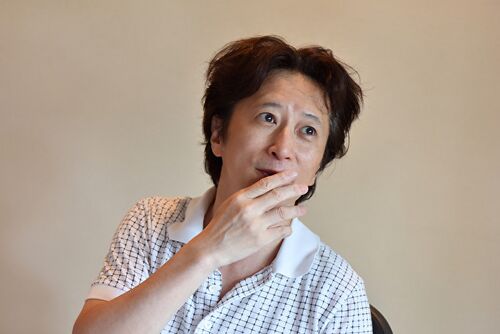
(Photo: Seiji Tonomura)
"However, there is a line that must be kept between good and evil. 'JoJo' villains are happy to take advantage of others to achieve their ideals. II depict it from the perspective that no matter how noble an idea is, it is unacceptable. I'm able to draw more complicated villains than when I started the series, but that one point hasn't wavered.If you want to realize the philosophy, you have to do it even if you are alone. Don't take advantage of others."
JoJo isn't a manga that always depicts victory on the hero's side. Defeat is also depicted as an important scene as much as victory. Araki-san says that there is another theme put into JoJo.
"I portray them as defeated, but never inferior. It's not the catharsis of victory that I want to depict. Maybe that would be more popular, but it deviates from what I want to draw. I am interested in what a person chooses to do in the process of fighting. Death is not the end of a person. Another theme of "JoJo" is to leave a will to those who are left behind and to pass it on. Even if defeated, someone will inherit the will. I think that's the beauty of being human."
Manga artists are also 'painters'
There is a word that Araki-san often uses as a set with 'Royal Road'. It's "suspense". Suspense is what Araki-san thinks is the foundation of 'good' stories and 'interesting' stories.
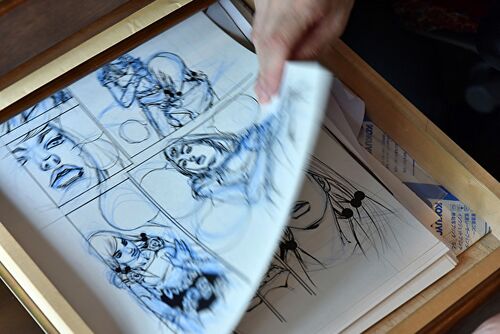
Exciting developments continue in Part 8 (Photo: Seiji Tonomura)
“Around the time I made my debut as a manga artist, Truffaut (a leading director of the French film movement 'New Wave' since the late 1950s) interviewed Hitchcock in a book called The Art of Pure Cinema. That's where Hitchcock, the master of suspense, explains his films in detail one by one. From the position of the camera, to the techniques for depicting psychological expression, and how to shoot the film, it is really detailed. While reading this, I studied by watching videos and Hitchcock's films again at the Masterpiece Theater."
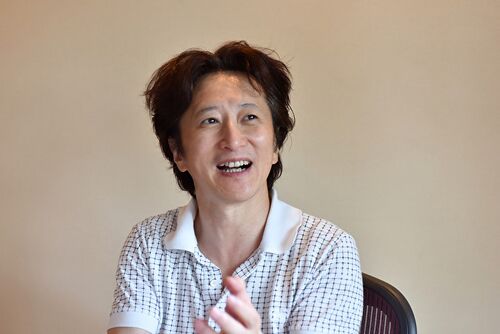
(Photo: Seiji Tonomura)
He wants to draw suspense. With that in mind, he extracted theories from his favorite movies and incorporated them into his own manga. Even now, in pursuit of universal "interesting" things, input is necessary.
Araki also professes the influence of Italian paintings by Leonardo da Vinci and others. With the full cooperation of the Louvre, he has painted works set in the Louvre.
"Manga artists are also 'painters' because they draw pictures. I want you to see it as a picture," says Araki.
"I think you will see something completely different from the printed manga. The original picture has a charm different from the printed one. Originally, I didn't draw with the intention of being printed. Regardless of the form in which it is printed, I have drawn it properly. I think you can feel its charm from the original drawings."
"The unique 'JoJo Stand' pose that fans all imitate is also cool when you see it in the original picture, isn't it?", Araki replies without pause.
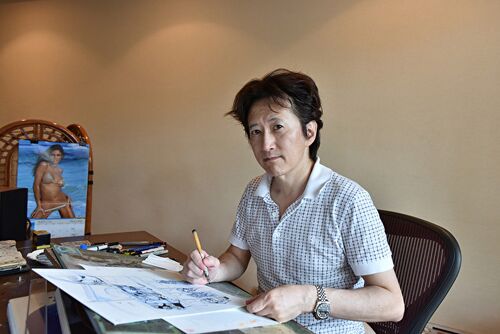
Beside the work desk, there is a favorite calendar. The figure of a woman looks somewhat like a "JoJo Stand" (Photo: Seiji Tonomura)
"Thank you, I really want you to see the details."
Araki-san has continued to draw new manga for over 30 years, while not being swept away by the times, but flexibly incorporating changes.
Finally, we asked about the development of the Part 8 'JoJolion', which is about to enter its climax.
"I don't draw a story with a detailed plan. I don't decide on the goal from the beginning, but think about it as I draw. The overall composition and fight are the same. From now on, the stage of Part 8 will move to the hospital. I think the story is finally coming together."
Heading to a climax that has not yet been decided, Araki is still thinking about it today as he sits at his desk and runs his pen. [1]
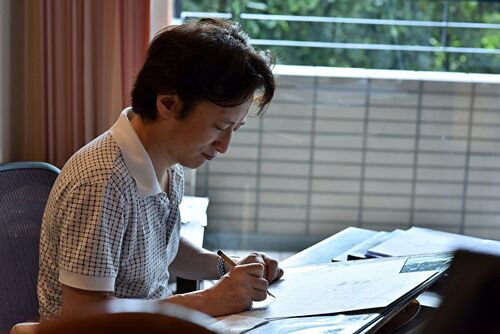
[Translated by LocacacaFarmer]

「これ以上、王道の漫画はない」――荒木飛呂彦が「ジョジョ」を描き続ける理由 8/17(金) 9:26 配信
8月24日から東京の国立新美術館で「荒木飛呂彦原画展 JOJO 冒険の波紋」が開催される。国立美術館としては、手塚治虫以来28年ぶりとなる漫画家の個展。週刊少年ジャンプ黄金期を支え、30年以上も続く「ジョジョの奇妙な冒険」が主役だ。単行本は通巻120巻を超え、スピンオフ作品も生まれた。各界を代表するクリエーターや漫画界でもファンを公言する人が多い。独特の絵柄とストーリー展開から「ジャンプでは異端」の作品と呼ばれながらも、荒木さんは「これ以上、王道の漫画はない」と断言する。キーワードは「信じる道を歩むこと」。そして「切り開く力」――。(石戸諭/Yahoo!ニュース 特集編集部)
王道に反する「異端」

いつもの作業机でペン入れをする荒木さん(撮影:殿村誠士)
58歳になる荒木飛呂彦さんは窓際にある大きな机でペンを走らせていた。机上には作画の参考にした馬のフィギュアと折り紙のカエルがある。物として手に取るためだ。
細部の「リアリティー」が作品の生命線であり、世界を支える。そんな強いこだわりが垣間見える机だ。
「僕にはこの机さえあればいい。そうすれば漫画が描けるから……」
描いているのは、連載中の「ジョジョの奇妙な冒険」第8部に当たる「ジョジョリオン」の最新話だった。原画展を前に、ミステリアスな物語は終盤に差し掛かっている。

「ジョジョ」第7部でカギとなる馬のモチーフとなったフィギュア(撮影:殿村誠士)
人気がなければ容赦なく打ち切られる少年漫画誌を中心に、荒木さんは30年以上にわたって「ジョジョ」の物語を描いてきた。今でこそ多くの人がファンを公言しているが、長く「異端」の存在だった。クラスの大半が話題にしあう作品というよりは、数人がひっそり集まって「実は『ジョジョ』好きなんだよね」「俺も」と打ち明け合うような、そんな漫画だった。その理由は独特の設定とストーリー展開だ。
連載開始は1987年。その4年前に連載が始まった「北斗の拳」がテレビアニメ化されて大ブレイク。3年前には「ドラゴンボール」が、2年前には「聖闘士星矢」がスタートしていた。荒木さんいわく、「少年漫画に集まった天才たち」による大ヒット作が次々に生まれた時代だ。

荒木さんが面白いと思った漫画の数々が、本棚の最上段に並ぶ(撮影:殿村誠士)
主人公が敵を倒す。するとさらに強い敵が現れ、その先にさらに強い敵が現れる、いわゆる「トーナメント方式」でストーリーが展開される漫画こそが少年漫画の「王道」で、部数も人気も集中した。読者が共感しやすいように、主人公は日本人の少年か青年であることが多い。舞台設定は、学校や身近さを感じさせる町だった。
「ジョジョ」は、いずれの点でも王道に反していた。
30年以上続く物語は、こう始まる。舞台は19世紀、1880年のイギリス。父の死をきっかけに名門貴族ジョージ・ジョースター卿の養子となった貧民街出身の少年ディオ・ブランドーは、ひそかにジョースター家の乗っ取りを計画。少しずつ、ジョージの一人息子、ジョナサン・ジョースターを追い詰めていくが――。

「ジョジョの奇妙な冒険」第1部「プロローグ」から。ジョナサン(上)とディオの出会いのシーン ©荒木飛呂彦/集英社
しかし、と荒木さんは断言する。
「これ以上、王道の漫画はない」
それはなぜか?
「トーナメント方式」全盛時代を乗り越える
初代「ジョジョ」担当にして、デビュー前から荒木さんの作品を見てきた編集者、椛島良介さんは当時をこう振り返る。
「早々に打ち切りを覚悟したし、設定にも懸念があった」

さまざまなジャンルの資料が並ぶ、仕事場の本棚(撮影:殿村誠士)
根拠はあった。荒木さんの「ジョジョ」以前の連載はいずれも短命に終わっている。椛島さんは理由をこう分析する。
「魅力的なキャラクターが足りなかった。主人公がいくら立っていても、それに並び立つようなライバルや敵キャラがいなければ成立しない。そこにきて次の作品は19世紀のイギリスを舞台に貴族が主人公だと言う。心配になりました。外国人の主人公が成功するわけない」
しかし、荒木さんは折れなかった。
「だったら、とスタートしました。ストーリー展開はもともと高く評価されていましたから、当時の編集長からもOKが出た。これまでと違うと思ったのは悪役です。ディオという悪役が実に良かった」
椛島さんは、少年漫画のキャラクターで魅力を高めるのは悪役なのだ、と語る。
「貴族のジョナサンは間違ったことができず、常に紳士でないといけない。正論ばかり言う『良い子キャラ』では共感を得られない。人間を超えたいと願う悪役のディオが対比して置かれることで、ストーリーが輝く」
それでも、「ジョジョ」の人気はなかなか出なかった。

「ジョジョ」の描画を支える道具たち(撮影:殿村誠士)
ここで荒木さんは、椛島さんも驚く手を打つ。主人公の交代だ。
ジョナサンが主人公の第1部から、第2部はジョナサンの意思を受け継ぐ子孫、ジョセフ・ジョースターを主人公にした明るい冒険活劇で物語を盛り上げた。
これが同時に、トーナメント方式を回避するという効果をもたらした。以降、「ジョジョリオン」に至るまで8人の主人公を通して「ジョジョ」は描かれてきた。
荒木さんが振り返る。
「当時はバブルに向かうころでしたから、時代の空気は上へ、上へと向かっていたんです。トーナメント方式を採用したマンガは時代の空気と重なっていました。僕はその空気に乗れなかった。上に行ってもいずれ頭打ちになったら、どうしたらいい?って考えてしまうんです」
だからこそ、時代に流されず、自分が描きたい漫画を描くことが大事だったのだという。
「僕はサスペンスを描きたいのであって、それ(トーナメント方式)は描きたい漫画ではない。自分が描きたいものがぐらついたら漫画は終わりです」

(撮影:殿村誠士)
そして「スタンド」でブレーク
信じたものを描き続けることで、やがてブレークの時がやってくる。
ロードムービーの手法を取り入れ、ジョースター家の血統を継ぐ日本の高校生・空条承太郎が仲間とともに、よみがえった一族の宿敵・DIO(ディオ)を倒すべくエジプトに向かう第3部が転機になる。
「ジョジョ」の世界観を象徴する、超能力を擬人化した「幽波紋(スタンド)」というアイデアが初めて使われた。椛島さんは「これでヒットだ」と思ったという。
「1部と2部で使っていた『波紋』という超能力は地味で、荒木さんのストーリーの面白さを引き立てるのに、これではダメだと思った。だから3部では新しいアイデアにしてくれ、と言いました。そうして誕生したのがスタンド。誰も見たことがない発想だし、3部にして主人公も悪役もハマっている」

スタンドが初めて詳しく語られるシーン。第3部「空条承太郎 その③」から©荒木飛呂彦&LUCKY LAND COMMUNICATIONS/集英社
スタンドの能力は人それぞれ違う。力と力がぶつかり合い、力が強いものが勝つという少年漫画のパターンをなぞるのではなく、能力同士の相性や知恵を使う頭脳戦というメソッドを確立した。
弱すぎるがゆえに逆に手ごわくなる敵キャラクター、トランプやテレビゲームまでバトルのなかに取り入れた。頭脳戦は今でこそ、多くの少年漫画が採り入れている方法だが、その道を切り開いたのは「ジョジョ」だ、と言えるかもしれない。
荒木さんは言う。
「波紋はダメだと言われたので、どうしたらいいのだろうと考えました。超能力を漫画で表現するという発想の延長で擬人化はどうだろうと思い付いたのです。ジャンプでは、他の先生方のアイデアを使ったと思われることもNGでしたから、絶対にやってないことをやろうと思った。それもあってか、はじめはスタンドとは何かがほとんど理解されなかった。『スタンドってなんなの?』ってよく聞かれましたよ」

第8部『ジョジョリオン』まで、「ジョジョ」シリーズは30年以上続いている(撮影:殿村誠士)
承太郎たちがエジプトに向かうまで、インドなどをすごろくのように訪れ、そこで戦う。トーナメント方式のように次から次へ強いキャラクターやスタンドが出てこなくてもストーリーはうまく展開する。
荒木さんは戦いに「必然性」があればいいと考えていた。力が強い敵が単純に出てくるより、能力を生かした敵のほうが「怖い」。怖さがあれば、物語は前に進んでいく。
大人気となった第3部でもDIOを倒して、物語は潔く完結する。第4部では設定も大胆に切り替え、日本の杜王町という小さな町を舞台にした。高校生の主人公・東方仗助が町に潜む連続殺人犯を探し出すという、サスペンス色を強めた展開を採り入れた。
荒木さんは、2000年に出版された画集『JOJO A-GO!GO!』のなかで、好きなキャラクターの1位に東方仗助を選んでいるほど思い入れが強い。
「第4部は初めて日常を描くことができたって思ったんですよね。それまでは神話を描いているような気分だったんです。承太郎はクールで、ある意味で完成されている。でも仗助はその辺(空いている椅子を指さす)にいるような感じ。すぐそばにいるキャラクターなんです」

第4部の主人公・東方仗助。普段は温厚だが、髪形をけなされると「プッツン」する。「ジョジョの奇妙な冒険」第4部「空条承太郎!東方仗助に会う その①」から©LUCKY LAND COMMUNICATIONS/集英社
日常に潜む恐怖を描ける力を付けたことで、「ジョジョ」の型は完成し、第8部まで新しい要素を貪欲に取り入れながら物語は進む。
「常に前向きでなくてはいけない」
主人公も設定も変わるのに、なぜ一本の漫画として続けているのか。それは「人間賛歌」という一貫したテーマがあるからだ。過去の著作で荒木さんはこう語っている。
「『人間は素晴らしい』という前向きな肯定です。何かの困難に遭ったとき、それを解決し、道を切り拓いていくのは人間の力によるのであって、そこで急に神様が来て助けてくれたり、魔法の剣が突然落ちてきて、拾って戦ったら勝ってしまった、という都合のいい偶然は『ジョジョ』ではけっして起こりません」(『荒木飛呂彦の漫画術』から)
作品を貫くテーマがあり、少年漫画のルールにのっとっているからこそ、ジョジョは「王道」なのだと荒木さんは語る。

(撮影:殿村誠士)
「僕が『ジョジョ』を王道だと呼ぶのは、主人公、悪役であってもキャラクターの志は前向きだからです。そこに悩む人物は描かない。人生に悩むのは普通のことなので、退屈になってしまう。前向きな志同士がぶつかり合うことで、化学変化やサスペンスが生まれると思って描いています。登場人物のベクトルは常にプラスに向かっていないといけない。大原則は成長すること。闘うことに悩まないこと。そして、闘うときは孤独であることです」
「ジョジョ」の登場人物は主人公であれ、悪役であれ、「血統」や「運命」といった自分の力ではどうすることもできない現実に直面しながら、それに抗い、自らの力で道を切り開こうとする。
「少年漫画の登場人物は常に前向きでなくてはいけないというのがルールです。後ろ向きになる、闘うことを悩み続けるというマイナスな要素を入れ込むと、読者はうんざりしてしまう。『ジョジョ』はこのルールに忠実にのっとっている。だから、王道だと言ってきました。主人公たちを過酷な状況に追い込み、成長しながら道を切り開かせる。闘うときに、偶然や誰かに頼っているようでは『ジョジョ』は成立しません。1人で立ち向かわなければいけないのです」

第8部『ジョジョリオン』が進行中(撮影:殿村誠士)
悪役さえ前向き
荒木さんは、悪役であってもこのルールを適用している。
「例えば第4部のボスである連続殺人犯、吉良吉影がそうです。吉良がやっていること自体は許されないのですが、彼には反省も迷いもありません。自分自身を認めているんですね。自分自身の平穏な生活のために、主人公たちに追い詰められてもなお闘いに挑み、自分で道を切り開こうとする。だからスタンド能力も成長していくんです」

スタンド「キラークイーン」を駆使する殺人鬼・吉良吉影。第4部「シアーハートアタック その⑨」から ©LUCKY LAND COMMUNICATIONS/集英社
善か悪かは実のところは「表裏一体」なのだと荒木さんは言う。敵には敵なりの信念があり、闘うべき理由がある。第7部最大の悪役である大統領も彼には彼なりにアメリカという国を繁栄させたいという私欲を超えた動機があった。
「最終的な善悪の判断は読者の視点次第でいくらでも変わります。キャラクター次第で変わり、それが激突する。『ジョジョ』の登場人物はとにかく成長したいと思っています。陰湿な敵であっても自分の信念を貫いていたり、高潔だったりすれば読者からの共感は得られる。ここが重要なんですね。前向きだと怖いんです」
主人公とベクトルが同じ前向きな悪役を配置することで、「ジョジョ」の世界観に不可欠な恐怖感は増す。

(撮影:殿村誠士)
「ただし善悪を分ける、守るべき一線はあります。『ジョジョ』の悪役は自分の理念を実現するために他人を利用することをよしとする。いくら高潔な理念があったとしても、これは許されないという視点で描いています。連載開始時よりも悪役を複雑に描けるようになりましたが、その一点はぶれていないですね。理念を実現したいなら一人であってもやらないといけない。他人を利用してはいけない」
ジョジョは常に主人公側の勝利ばかりが描かれる漫画ではない。敗北もまた勝利と同じくらい重要なシーンとして描かれる。そこにジョジョに込めた、もう一つのテーマがあると荒木さんは言う。
「敗れはしても、決して負けていないと描いています。僕が描きたいのは勝利のカタルシスでは無いんです。そのほうがウケがいいのかもしれないけど、僕が描きたいものからはずれてくる。戦う過程のなかで、その人間が何を選択するのかに僕は興味がある。人は死んで終わりではない。残された人に意志を残し、受け継がれていくというのが『ジョジョ』のもう一つのテーマなのです。敗北したとしても、誰かが意志を継いでいく。僕はそれを人間の美しさだと思っています」
漫画家も「画家」である
「王道」とセットで荒木さんがよく使う言葉がある。それは「サスペンス」だ。サスペンスとは、荒木さんが考える「良い物語」「おもしろい物語」の基礎にあるもの。いったい、この後どうなってしまうのか。読者がドキドキしながら、ページをめくらずにはいられなくなる要素だ。

第8部もドキドキの展開が続く(撮影:殿村誠士)
「漫画家としてデビューしたころにトリュフォー(1950年代末からのフランスの映画運動「ヌーベルバーグ」を代表する映画監督)がヒチコックにインタビューをした本『映画術』が出たんですよ。そこで、サスペンスの巨匠であるヒチコックが自分の映画を一作ごとに細かく解説しているんです。カメラの位置から心理描写のテクニック、映画の撮り方が本当に細かく書いてある。これを読みながら、ビデオや名画座でヒッチコックの映画をまた見て勉強しましたよ」

(撮影:殿村誠士)
サスペンスを描きたい。その一心で好きな映画から理論を抽出し、自身の漫画に取り入れた。普遍的な「おもしろい」ものを求めて今でもインプットは欠かさない。
荒木さんはレオナルド・ダビンチらによるイタリア絵画の影響も公言している。ルーブル美術館全面協力のもと、ルーブルを舞台にした作品を描いたこともある。
「漫画家も『画家』です。絵を描いていますからね。絵として見てほしいんです」と荒木さんは言う。
「印刷された漫画とはまったく違うものが見えてくると思います。原画には印刷されたものとは違う魅力があります。もともと、印刷されるという意識で僕は描いていないんです。どんな形で印刷されるかに関係なく、きちんと描いてきました。原画からその魅力を感じ取ってもらえると思います」
ファンがこぞって真似する独特のポージング「ジョジョ立ち」も原画で見るとかっこいいですよね、と言うと、荒木さんは間髪をいれずにこう返す。

作業机の傍らには、お気に入りのカレンダーが。女性の姿はどことなく「ジョジョ立ち」風に見える(撮影:殿村誠士)
「ありがとうございます。本当に細かいところまで見てほしいです」
時代に流されず、しかし、しなやかに変化を取り入れながら30年以上にわたって荒木さんは新しい漫画を描き続ける。
最後に、いよいよクライマックスに突入しそうな第8部「ジョジョリオン」の展開を聞いてみた。
「僕は細かく展開を決めながら物語を描くことはありません。最初からゴールを決めるのではなく、描きながら考えています。全体の構成も、一つ一つの闘いも同じ。これから第8部の舞台は病院に移っていきます。いよいよ物語が収れんしていくと思います」
まだ決まっていないクライマックスに向かい、荒木さんは今日も考えながら机に向かい、ペンを走らせている。[2]

References
Site Navigation
